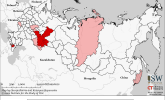Russian Offensive Campaign Assessment, July 23
July 23, 2022 - ISW Press
Ukrainian forces are likely preparing to launch or have launched a counteroffensive in Kherson Oblast as of July 23, but open-source visibility on the progress and tempo of the counteroffensive will likely be limited and lag behind events. Ukrainian Kherson Oblast Administration Adviser Serhiy Khlan stated on July 23 that Ukrainian forces have seized unspecified settlements in Kherson Oblast but called on Ukrainian civilians to remain silent on the progress of the counteroffensive until Ukrainian authorities release official statements. Foreign Policy National Security Reporter Jack Detsch reported on July 22 that an unspecified senior US defense official stated that Ukrainian forces have recaptured unspecified “portions of Russian-occupied villages” in Kherson over the past week of July 15-22, indicating that Ukrainian forces have made some unspecified territorial advances along frontlines. The area between the front line and Kherson City is rural and primarily composed of small settlements that are less likely to report on force movements and engagements, allowing control-of-terrain in this area to change without evidence appearing in open-source reporting. Russian authorities additionally have no incentive to report on Ukrainian territorial gains. The informational dynamics that allow ISW to report on Russian offensive operations with relatively little lag are thus inverted in this situation. ISW will report on the progress of any Ukrainian counteroffensives to the best of its ability within these constraints.










